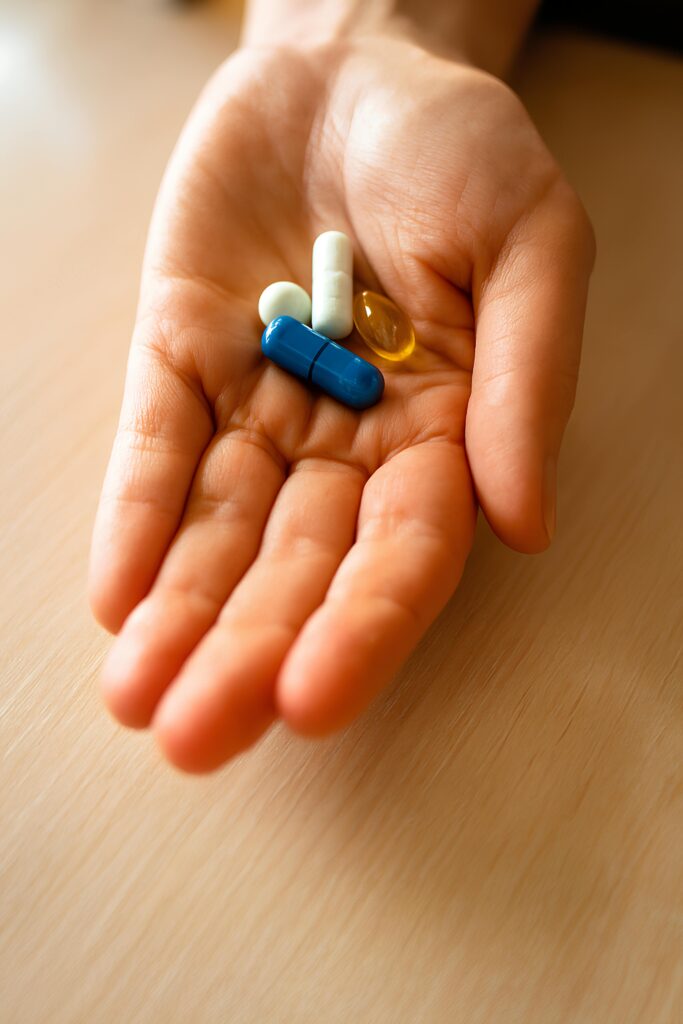Vitamin D3 supplements for my bones and joints health

Introduction
Vitamin D has two primary forms: D2 (ergocalciferol) and D3 (cholecalciferol). While both can increase the number of vitamins in the D complex, vitamin D3 is superior and longer acting in the bloodstream. Although both can elevate vitamin D levels, vitamin D3 is superior and more extended in its effect in the bloodstream. It’s produced in the skin when exposed to sunlight, which is why it is (naturally) synthesized. Still, many people don’t get enough due to the modern lifestyles of indoor living, sunscreen use, pollution, and latitude.
D3 differs from other vitamins, working like a hormone that turns on more than 200 genes. One of its primary functions is to assist the body in absorbing calcium and phosphorus, two essential minerals in building and maintaining bones.
How Vitamin D3 Supports My Bone Health
Bones are living tissue; they break down and reassemble all the time. Vitamin D3 supports this process by:
1. Enhancing Calcium Absorption
Dietary calcium is the primary mineral in bones; without sufficient vitamin D3, less than a quarter of it is (absorbed) from food. Vitamin D3 moves calcium from the digestive tract into the bloodstream and to bones and teeth.
2. Regulating Parathyroid Hormone (PTH)
Deficiency in vitamin D3 levels stimulates the release of more PTH from the parathyroid glands, leading to increased calcium extraction from bones and, thus, reduced bone density over time.
3. Reducing the Risk of Osteoporosis
Vitamin D3 deficiency is related to osteoporosis, in which bones become brittle and fragile. Supplementation, particularly when coupled with calcium, has been found to lower fracture risk, especially in older adults.
Recent Studies on Vitamin D3 and the Health of Bone and Joints
There has been a recent explosion of scientific interest in vitamin D3, especially its effects on bone metabolism, chronic pain, and joint inflammation. Here are some recent findings that one cannot help but notice.
1. Bone Mineral Density (BMD) Studies
Bone and Mineral Research A meta-analysis of 2023 studies revealed that vitamin D3 and calcium supplementation greatly improved bone mineral density in postmenopausal females and aging people’s spine and femoral neck.
2. Arthritis and Autoimmunity
Harvard Medical School researchers reported that patients with rheumatoid arthritis (RA) had significantly lower vitamin D levels. In several small clinical trials, supplementation with D3 enhanced joint stiffness and lowered disease activity scores.
3. Pain Reduction in Deficient Individuals
According to the Pain Physician Journal, musculoskeletal pain improved remarkably within 8 weeks of vitamin D3 therapy in formerly deficient persons. The mechanism is related to neuromuscular function and the control of inflammation.
These studies emphasize that vitamin D3 does more than shield bones; it actively promotes the joint-muscular consistency we need as we age.
Natural Sources of Vitamin D3
Supplements are convenient; it’s also helpful to know what natural sources of vitamin D3 are:
- Sunlight: A few times a week, 15–20 minutes of exposure of the face, arms, and legs to the sun.
- Fatty fish: Salmon, mackerel, sardines, and tuna.
- Cod liver oil: A natural source complete of vitamins A and D (traditionally).
Note: Fortified foods (milk, orange juice, and cereals) tend to contain Vitamin D2, which is less effective than D3.
Real-Life Tips for Bone and Joint Health Improvement
Besides taking a good vitamin D3 supplement, the following are ways of living with healthy bones and joints:
Strength Training
Resistance exercise promotes bone development and joint lubrication. Do 2–3 workouts per week to concentrate on large muscle groups.
Bone-Friendly Diet
Include leafy greens (for magnesium and Vitamin K), nuts, seeds, dairy or fortified alternatives, and oily fish such as salmon.
Daily Movement
Activities that require little effort, such as walking, yoga, or swimming, keep the joints in motion and prevent stiffness.
Stay Hydrated
Water is the main constituent of joint cartilage. Optimal hydration helps mediate joints and enriches the supply of nutrients.
Vitamin D3 and other nutrients’ correlation
To ensure that vitamin D3 is effective, your body needs cofactors in the form of co-nutrients, which act synergistically to boost and maintain bones and joint health. These include:
Vitamin K2
- Shuts calcium into bones and away from soft tissue like arteries.
- It is essential when used in high doses of vitamin D3.
Magnesium
- Compelled to convert vitamin D3 into calcitriol – its active compound chemically.
- It also assists in the control of muscle function, thus supporting joint stability.
Calcium
- The primary mineral in bones is vitamin D3 for proper absorption.
- You don’t always need supplementation if your diet is nutritious.
Omega-3 Fatty Acids
- Help reduce inflammation in joints.
- It may improve the bone-supporting effect of vitamin D3.
Vitamin D3 and Aging Bones
The older we get, the slower our bone remodeling and calcium absorption decreases. It makes postmenopausal women particularly susceptible to the following:
- Osteopenia (low bone mass)
- Osteoporosis
- Hip and spine fractures
Vitamin D3 coupled with calcium can decrease fracture risk by as much as 20%, especially in older people.
Proper maintenance of D3 also increases muscle strength, which prevents falls and helps improve balance, a vital aspect of bone safety for older people.
Who Consider Taking Vitamin D3 Supplements?
Although anyone can be affected, specific groups run the highest risk for vitamin D3 deficiency:
- Older adults: The production of vitamin D is (superbly) enhanced by old age on the capacity of the skin to do so.
- People with limited sun exposure: Office workers, residents in higher latitudes, or regular users of sunblock.
- Darker-skinned individuals: It inhibits the skin’s ability to synthesize vitamin D Melanin.
- Those with gastrointestinal issues: Absorption can be (impacted) by diseases such as Crohn’s, celiac or even IBS.
- Vegans and vegetarians: The most natural sources of D3 are animal sources (e.g., fatty fish, liver, and egg yolks).
A simple blood test can check your 25 (OH) D level to see if supplementation is required.
Choosing the Right Vitamin D3 Supplement
When choosing vitamin D3 for bones and joints, use:
Form:
- Softgels and liquid drops are absorbed better than tablets.
- The liposomal or micellized forms are (characterized) by improved bioavailability.
Dosage:
- An adult’s daily vitamin A intake should amount to 600–800 IU, with doses of 2000–5000 IU (being taken) under a doctor’s care in a deficient diet.
- Look for D3 (cholecalciferol) rather than D2.
Combined Formulas:
- Vitamin K2 (MK-7)- containing products can guide calcium to bones and out of arteries.
- Some formulations contain magnesium and calcium for an entire bone support system.
Quality and Purity:
- Select brands that third parties have tested.
- Search for non-GMO, free from gluten, and free from unnecessary additives.
Judgment
Vitamin D3 is well beyond being dubbed the “sunshine vitamin.” It is vital in ensuring strong bones and healthy joints, avoiding inflammations, and lowering the chances of fractures and joint degeneration. Supplementation may be a simple but effective means of ensuring bones are (protected) for those living in areas away from the sun’s rays or finding it difficult to obtain nutrients from food.
Whether you’re looking to avoid osteoporosis, relieve your joints of pain, or bolster your foundation from the inside out, vitamin D3 can be the missing key nutrient your body needs.
